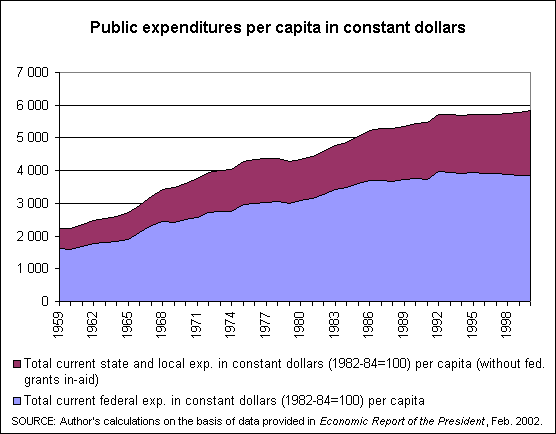 |
 |
 |
 |
| Montreal, March 16, 2002 / No 100 |
|
by
Pierre Lemieux
In current fiscal year 2002, U.S. federal expenditures have started increasing again as a proportion of GDP (gross domestic product), and a deficit has reappeared. But is it really true that public expenditures had previously receded? If so, how can we reconcile this with what appears to be increasing state presence over the past two decades? |
| A
Measure Based on GDP
Let’s have a look at official data in the U.S. national accounts.(1) From 1959 to 1983, total public expenditures (all levels government, but without capital expenditures) grew from 23 percent of GDP to nearly 32 percent. The ratio went down to around 30 percent during the expansion that marked the rest of the 80s, but was back to 32 percent by the early 90s. The last two thirds of the 90s were characterized by rapid economic expansion and, at the end of the decade, the ratio had receded to 28 percent (i.e., where it was in the late 70s). In relation to the economy, then, there has been a stabilization of public expenditures (around 30 percent of GDP) during the last part of the 80s, and a reduction (to about 28 percent) during the last part of the 90s. Remember that, apart from any change in its numerator (government expenditures), the ratio moves inversely to its denominator (GDP): other things being equal, it goes down with an economic expansion, and up with a downturn. Indeed, fast economic growth was the main factor in the stability of the ratio in the last part of the 80s. The expansion of the 90s also dampened the ratio, but (as we shall see) with a more significant role for the evolution of government expenditures. We may wonder what those global measures mean. Total government expenditure ($2.8 trillion in 2000) has a clear intuitive meaning, since it represents resources taken away from taxpayers. But GDP ($9.9 trillion in 2000), which purports to measure total production within the U.S., is a tricky construct. GDP is under the control of nobody and enters into no entity’s bank account; indeed, if the government did not calculate it, nobody would. Estimating this broad aggregate is not only statistically difficult, but also depends on the prices of goods and services. If these prices are distorted by state intervention, GDP may be more a reflection of what the state wants than of how the people value production. For these reasons, Austrian economists reject the very notion of GDP, a creation of Keynesian macroeconomic management. These critiques of macroeconomic concepts like GDP may very well be correct, and we would be no worse-off if GDP was not calculated. Yet, perhaps the ratio of government expenditures to GDP does provide a rough measure of their relative importance over time – if we don’t take seriously small variations over small periods of time. But we better check the results against other evidence.  If we take real public expenditures per capita, we can dispense with the concept of GDP. As our chart shows, this gives a somewhat different picture of the evolution of public expenditures. In constant 1982-84 dollars, they have grown regularly over the whole period covered by our data. In the late 50s, the state (all levels of government) spent $2,224 for every man, woman and child in the U.S.; in 2000, this amount had reached $5,847 (which amount to more than $10,000 in current dollars). The progression has been slow during the last two thirds of the 90s, but not too much can be made of this: per capita real expenditures had also leveled clearly in the late 70s. Indeed, they seemed to pick up speed again in 2000 – before 9/11. Interestingly, real per capita federal expenditures were flat or were declining during the 90s, but State and local governments made up for more than the difference. This may have resulted from the transfer of some responsibilities from the central government to State governments. Growth of Government Under Reagan It is quite remarkable that, under President Reagan, federal expenditures, and especially social expenditures, continued to grow. During his two-term presidency, total federal expenditures grew 24 percent in constant dollars (although, given brisk economic expansion, this translated into a small drop from 21.7 percent to 20.8 percent of GDP). More strikingly, health expenditures (excluding Medicare) grew 32 percent in real terms. Thus, the state has not really receded – except if we only consider public expenditures as a ratio to GDP, in which case 2000 was merely a return to the late 70s. Moreover, expenditures do not measure the whole presence of the state. As Geoffrey Brennan and James Buchanan wrote, “It is relatively easy to envisage a federal budget making up no more than 20 percent of GNP that would reflect more interference with personal liberties than an alternative budget of 40 percent of GNP, but with substantially less direct regulation.”(2) Indeed, there is much evidence that, after – or even despite – the timid deregulations of the early 80s, regulation has been growing again, and especially the sort of monitoring and surveillance that force people to behave as if they were constantly controlled by omnipresent bureaucrats. The state’s reactions to 9/11 have only intensified the trend. Although we must not close all avenues of piecemeal reform within the present system, we must be alert to the possibility that so-called “market-based reforms” actually work to maintain both (apparent) economic efficiency and government control. Read the Economic Report of the President: The Administration’s emphasis on patient-centered health care reform centers on three objectives. First, we must develop flexible, market-based approaches to providing health care coverage for all Americans. Second, we must support health care providers in their efforts to meet the demand for higher quality and value, in part by making better information available about providers, options, outcomes, and costs. And finally, we must provide the foundation for further innovation through strong support for biomedical research. (p. 19)Note how “we must” do something, how the state determines the objectives and “supports” the laity. The free-marketers’ hope is that market-based reforms will lead to a gradual disengagement of the state. The danger is that it will contribute instead to a new form of state capitalism, where the state formally does not plan, but where it monitors and regulates everything. During the last two decades, the state increased its expenditures and, more conspicuously, its networks of monitoring, surveillance and control. This can be observed not only in the U.S., but also in most, if not all, Western countries. Anybody who believes that this means a smaller state must be thinking in Newspeak, not in English.
|
| << retour au sommaire |
|